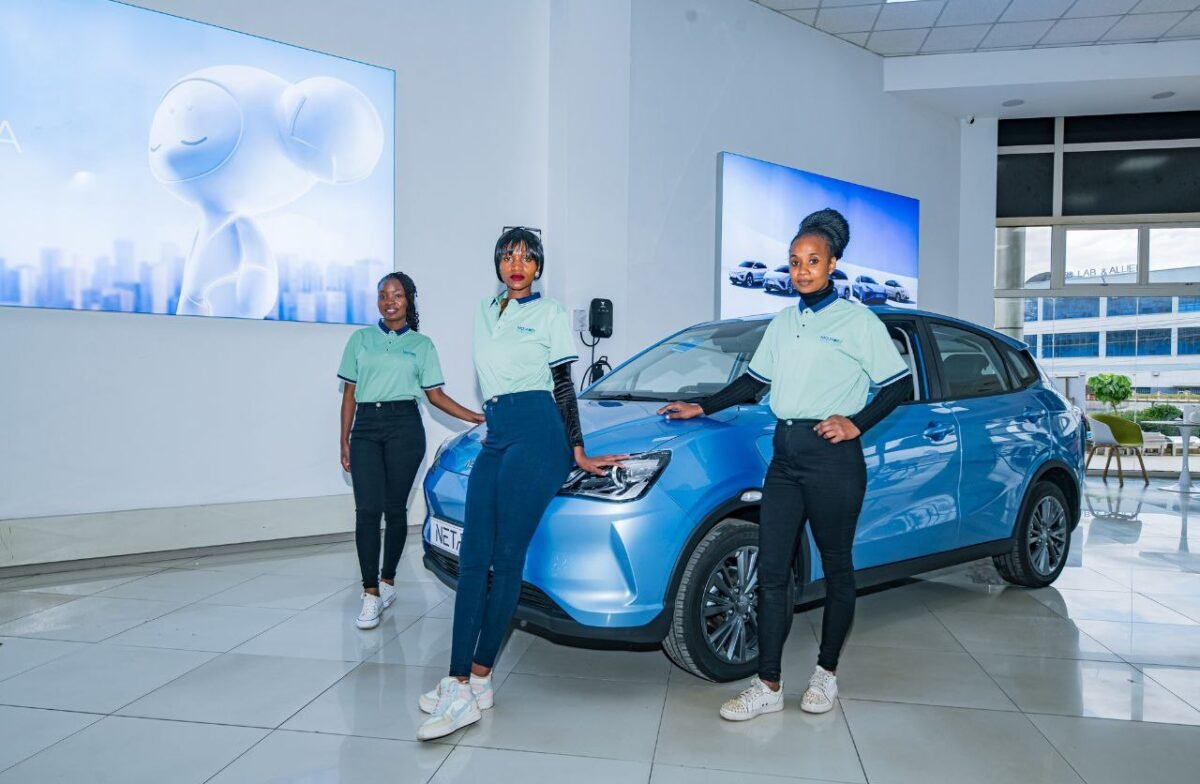Kenya is gradually transitioning toward a future where electric cars may become more common on the roads. Recent developments, such as billboards advertising electric vehicles (EVs) and the growing availability of these cars at local dealerships, suggest that progress is being made. However, while there are clear signs of advancement, Kenya’s infrastructure and market readiness still face significant hurdles. The key question remains: is Kenya truly ready for a widespread electric car revolution?
The Skyworth and Neta: New Entrants Shaping the EV Landscape
A recent video by Auto Konnekt Kenya highlighted two electric cars, the Skyworth SUV and the Neta EV, taking them on a road trip to test their capabilities. The Skyworth, boasting a 600 km range, and the Neta, with a more modest 300 km range, offer a glimpse into the types of EVs now available in Kenya. The video did an excellent job showcasing the vehicles’ modern features – customizable driving modes, infotainment systems, and battery efficiency.
Yet, this real-world test also revealed the growing pains of EV adoption in Kenya. The Neta needed to stop for a charge, pointing to one of the main challenges: the current lack of charging infrastructure. Kenya’s charging grid is still underdeveloped, and long-distance trips may not always be feasible without well-distributed charging stations. Until this changes, range anxiety will continue to deter many drivers from considering EVs as a practical option.
Billboards Signaling a New Era for Electric Cars
In Nairobi, billboards promoting electric cars, such as the KIA EV6, mark a new era in the local automotive landscape. These advertisements signal growing interest from manufacturers and dealerships, showcasing Kenya’s shift towards greener transportation options. But while these billboards are a positive sign of progress, they also raise important questions about whether the country is fully equipped to support this transition.

Kenya has already seen some success with electric cars in the public transport and delivery sectors. Electric buses, introduced by BasiGo, and electric motorcycles used by ride-hailing apps and delivery services, have been key areas of adoption. Additionally, electric Nissan Leafs are being used as Ubers. These developments suggest that public transport and commercial applications may be laying the groundwork for broader EV adoption. But are electric cars primarily suited for public transport in Kenya, or are these early adoptions part of the natural longer-term roadmap to build confidence in the technology before it reaches the private car market?
The Challenge of Broken Promises on Charging Infrastructure
One of the most pressing obstacles to widespread EV adoption is the lack of charging infrastructure. Both Kengen and Kenya Power had announced ambitious plans to develop a network of charging stations across the country, yet progress has been slow. Updates on these initiatives have been scarce, leaving potential EV owners uncertain about whether the grid will be capable of supporting their vehicles in the near future. Without more visible progress on this front, EV adoption will continue to be hindered.
Additionally, while home charging solutions were mentioned in the video, they present a cost challenge. Kenya Power’s electricity prices have been rising – even as the company continually becomes unreliable – making it expensive for consumers to rely on the grid for charging. More companies and households are now opting for solar power solutions to reduce their reliance on the national grid. However, installing solar charging stations can be costly upfront, making it less accessible for the average Kenyan household.
Can Kenyans Truly Embrace Electric Cars?
Despite the growing visibility of EVs, there are several challenges that may prevent widespread adoption. Internal combustion engine (ICE) vehicles still hold significant advantages, especially for long-distance travel. ICE cars can cover vast distances on a single tank of fuel, while electric cars require extended charging times. Kenya’s limited charging infrastructure exacerbates this issue, making ICE vehicles more practical for many drivers.
Home charging options are becoming available, but until the convenience of quickly refueling at a petrol station can be matched, many Kenyans may be reluctant to switch. The high costs of electricity, coupled with the lack of fast-charging stations along major highways, make the transition to electric cars less appealing.
Public Transport Leading the Way for EV Adoption
The uptake of electric vehicles in Kenya has so far been concentrated in the public transport sector and commercial services. The introduction of electric buses and motorcycles in Nairobi’s public transport system demonstrates the feasibility of EVs in commercial applications. This success could be a crucial step toward encouraging private car owners to consider EVs, as it builds public confidence in electric mobility. Seeing electric cars operate effectively in public transport could shift perceptions and make the general public more willing to explore EVs for personal use.
But there’s also the question of whether electric cars are better suited for public transport. Public vehicles typically have fixed routes and charging stations can be strategically placed along these routes, making the EV model more practical. In contrast, private car owners may struggle with Kenya’s fragmented charging network.
The Future of EV Regulation and Local Access
Another concern is the risk of older electric cars being imported into Kenya without proper regulation, leading to a dumping ground for outdated, less efficient models. While the Skyworth and Neta represent modern, cutting-edge EV technology, not all consumers will be able to afford new vehicles. Financing options are becoming available, but high upfront costs continue to deter many potential buyers.
The Kenyan government had promised green number plates for electric vehicles, a step intended to promote EV adoption. Yet, no significant progress has been made, as evidenced by the regular number plates seen on the electric cars featured in the video. This lack of regulatory follow-through could hinder efforts to promote EVs.
More broadly, there’s also been little movement in terms of tax incentives for EVs. With a price tag of KES 7 million, the Skyworth is competitive compared to traditional ICE SUVs. However, Kenya’s high taxation system means that a similarly priced ICE vehicle, like a 7-year-old Toyota Prado TZG, might still be more appealing. If the government were serious about promoting EV adoption, tax breaks and reduced duties could make these cars far more affordable and attractive.
The Case for Hybrids in Kenya
Given the current state of infrastructure, hybrid vehicles may offer a more practical solution for Kenya in the short to medium term. Hybrids combine the benefits of electric driving with the reliability of traditional fuel, making them less dependent on a sparse charging grid. For long-distance travel, hybrids offer the peace of mind that comes with not having to worry about finding a charging station.
A 1,000 km road trip in Kenya is far more feasible in a hybrid than in a fully electric vehicle. With a hybrid, drivers can avoid the anxiety of running out of battery in areas without charging stations. Until Kenya’s charging infrastructure becomes more reliable and widespread, hybrids may be the more realistic option for most drivers.
The Missing Pieces: Acquisition and Charging Costs
While the Skyworth’s KES 7 million price tag was mentioned in the video, other important cost factors were not clearly addressed. The overall cost of charging an electric vehicle in Kenya remains a question mark. How does the cost of home charging compare to refueling a petrol or diesel vehicle? Without clear data on charging costs, consumers may struggle to see the financial benefits of switching to electric.
Another concern is the lack of clarity around the insurance, repairs, and servicing of electric vehicles. As a relatively new market, EV owners may be unsure about the availability of technicians, spare parts, and support for battery-related issues. Until more assurances are provided in these areas, many consumers will remain hesitant.
Final Thoughts: Is Kenya Ready for Electric Cars?
Kenya is undoubtedly making strides toward a future where electric vehicles are more widely available. The appearance of EV billboards, the introduction of models like the Skyworth and Neta, and the success of electric public transport options all signal progress. However, significant challenges remain.
Kenya’s charging infrastructure is underdeveloped, electricity costs are high, and public awareness around EVs is still evolving. There’s a clear need for government incentives, better infrastructure, and assurance on maintenance and repair costs to make electric vehicles a practical option for the average Kenyan driver. Until these issues are addressed, fully electric cars may not yet be the best choice for the majority of consumers. For now, hybrids seem like the more sensible option, offering the benefits of electric driving without the limitations imposed by a still-developing support network.








